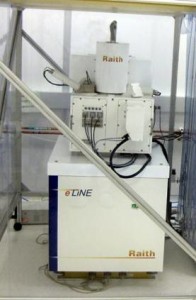OVERVIEW
 Generally, the term semiconductor refers to a material which has conductive properties between insulator and conductor, allowing it to act as either depending on the circumstances. In the context of nanotechnology, the semiconductor field relates to the research into and production of microprocessors to power computing devices (for a discussion of solar applications, please see our article on Energy). The first semiconductors were used in radios in the 1800’s. As the properties of semiconductor materials became better understood, their application to computing became clear. Transistors were added to semiconductor chips and the first microprocessors were born.
Generally, the term semiconductor refers to a material which has conductive properties between insulator and conductor, allowing it to act as either depending on the circumstances. In the context of nanotechnology, the semiconductor field relates to the research into and production of microprocessors to power computing devices (for a discussion of solar applications, please see our article on Energy). The first semiconductors were used in radios in the 1800’s. As the properties of semiconductor materials became better understood, their application to computing became clear. Transistors were added to semiconductor chips and the first microprocessors were born.
Since the introduction of the first microprocessors in the early 1970s, the race has been on to pack more and more transistors into a smaller area, thus boosting the microchip’s processing power. This drive for innovation is embodied in Moore’s Law, which states that the number of transistors on a chip will double every two years. Miraculously, the predictive power of Moore’s Law has held up since it was first articulated in 1965. This phenomenon has led to tremendous increases in processing speed, resulting in high power computers and ever smaller computing devices. As the global market for computing devices increases, the drive to innovate will only become more powerful.
 TECHNIQUES
TECHNIQUES
- AFM/SPM
- Lithography
- Probe Station
- Profilometry
- Pull Testing
- SEM/TEM
- Wire Bond
 ENVIRONMENTAL CHALLENGES
ENVIRONMENTAL CHALLENGES
Semiconductor research and production applications involve processes which operate at extremely high levels of precision on very small scales. It is not surprising that these processes exhibit sensitivity to environmental noise. Even normal levels of building acoustic and vibration noise can frustrate these sensitive measurements. Much semiconductor testing also involves gauging the conductivity of materials, making these processes sensitive to ambient levels of electromagnetic interference (EMI). Semiconductors are also sensitive to thermal fluctuation, another potential source for error.
A quiet environment can be difficult to attain for many semiconductor applications. A great deal of research, development, and product testing takes place in a clean room, a space designed to reduce particulate contamination. Unfortunately, clean rooms incorporate air handling equipment and raised floors, which can increase ambient levels of noise due to air currents, acoustic noise, and vibrations. Semiconductor process equipment can be another source of noise, as they incorporate moving parts, pumps, and water flow.
Before installing a sensitive instrument, it is recommended to survey the site with EMI, acoustic, and vibration measurement equipment to determine the best location. To ameliorate the effect of noise, vibration isolation systems, acoustic enclosures, and EMI cancellation systems may need to be employed.




